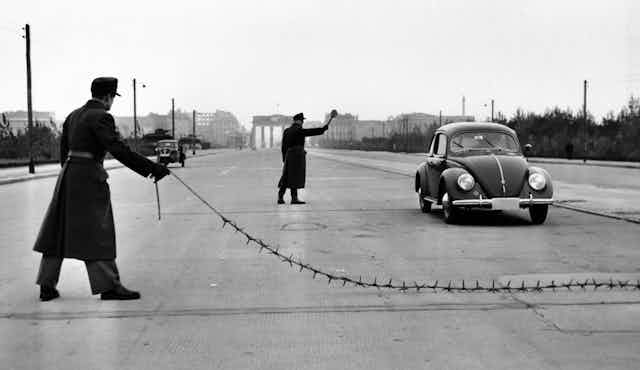Russia’s relationship with the West is on a knife edge, with multiple allegations of Russian involvement in the affairs of other countries. But are these the beginnings of “Cold War II”? And can Cold War history provide potential lessons for today’s politicians?
As US secretary of state Rex Tillerson prepares for talks in Moscow, Russia-US relations are at their lowest point since the end of the Cold War. Moscow’s continuing support for Bashar al-Assad’s “toxic” Syrian regime, alleged Russian involvement in the US Presidential election, sabre rattling with NATO and the French far right’s links to the Kremlin, point to an increasingly assertive Russia. Added to this are claims of an election-day plot in Montenegro, dismissed by foreign minister Sergei Lavrov as “unsubstantiated”.
In the West, Russia’s confidence has met with concern. Foreign secretary Boris Johnson warned that Moscow is “up to all sorts of no good”, and is pushing for tougher action against Russia and Syria following last week’s chemical weapons attack. Meanwhile, in Washington, there are increasing signs that president Trump’s detente with Moscow appears to have been derailed.

But there is concern in Russia about the West’s security agenda. Plans to install an anti-missile defence shield in Romania were described as a “real threat”. President Putin pointed to NATO build-up in Eastern Europe as a provocation and warned of Western efforts to undermine the Assad regime, Russia’s longstanding ally. Having a balanced look at Moscow’s security concerns, rather than just London or Washington’s, could give us a better insight into where we are now and how to address East-West tensions.
Lessons from the past
It may be useful to find parallels in Cold War history. It could be that we are at a “1946” moment – early tensions, leading to a worsening of relations. For all the talk of “Cold War” in 1946 Britain, the US and the Soviet Union actually remained committed to amicable discussions on post-war Europe.
Britain’s relationship with Moscow was set by Frank Kenyon Roberts, charge d'affaires at the British Embassy. In a series of letters to the foreign office in March of that year, Roberts painted a “sombre picture” about relations with the Russians.
From Moscow, Roberts warned that anti-British propaganda and the official line that the Soviet Union was “surrounded by enemies” did not bode well for the future. “The present state of Soviet relations … is very different from what we had hoped for”. Instead of a new post-war relationship, Britain faced a “policy designed to advance Soviet interests at every … opportunity”.
But Roberts was also keen to see things from the Kremlin’s perspective – especially on security. For Roberts, Russian policy was shaped by a “constant striving for [the] security of a state with no natural frontiers and surrounded by enemies”. Britain’s relationship with Russia, even before the Bolshevik revolution in 1917, was strained. Roberts didn’t downplay the ideological gulf between London, Washington and Moscow or the true nature of the Soviet system. But he understood the need to see Russia’s perspective.
Britain’s Joint Intelligence Committee (JIC) was also cautious. Hindsight shows they were remarkably accurate in forecasting Russian motives. For example, Soviet Cold War archives reveal that, rather than being bent on European dominance, the Kremlin’s policy aimed to ensure long-term security.
In March 1946, the JIC predicted the Soviets wanted “military security” and would avoid actions likely to “provoke a war” with Britain or the US. Key to Moscow’s security were the countries of Eastern Europe – behind the Iron Curtain – Poland, Bulgaria, Romania, Hungary, East Germany and the Baltics. If this “protective belt” was threatened, the JIC concluded that the Soviets would “retaliate by using all weapons … to frustrate these attempts. She will make full use of propaganda, of diplomatic pressure and of the Communist parties abroad … to weaken foreign countries.” This response is not too dissimilar from today’s – though cyber attacks and “fake news” take the lead. Western encroachment into former Russian spheres of influence, like Georgia and Ukraine, have provoked a significant response from Moscow.
Even as Cold War tensions started to grow in 1947, the JIC continued placing security at the heart of Soviet short-term policy. The Kremlin’s preoccupation with security – a view that Russia lacked “natural defensive frontiers” making her vulnerable – continued to be an important theme. Increasingly, ideology was another important factor. By 1948, the mood clearly changed: rather than being defensive, the Kremlin was judged to be intent on “the elimination of capitalism” -– a chilling assessment, ushering in the start of the Cold War and a final breakdown in East-West relations.
East-West animosity may increase to Cold War levels, but we shouldn’t see ourselves as locked in a struggle with Moscow just yet. Lessons from the start of the Cold War tells us that we still need to try and understand Russia’s underlying foreign policy motives. What may seem aggressive to us, could be defensive to Moscow – and vice versa.
Roberts and the JIC appreciated Soviet vulnerability alongside ideological motivations. If anything, we need to take into consideration present-day Russian security concerns as a way of understanding Moscow’s relationship with the outside world, rather than see Russia as irreversibly hostile to the West.

